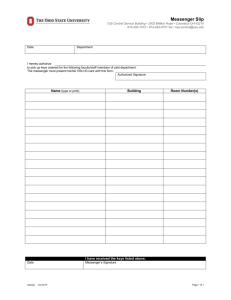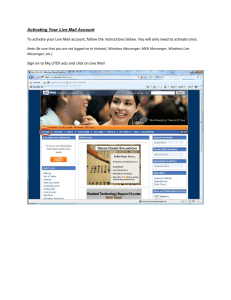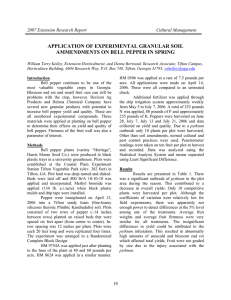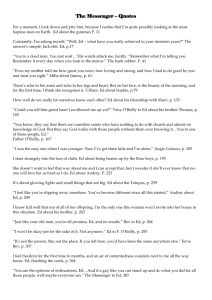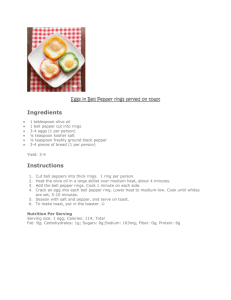EFFECT OF HARPIN PROTEIN (‘MESSENGER’) ON BELL PEPPER
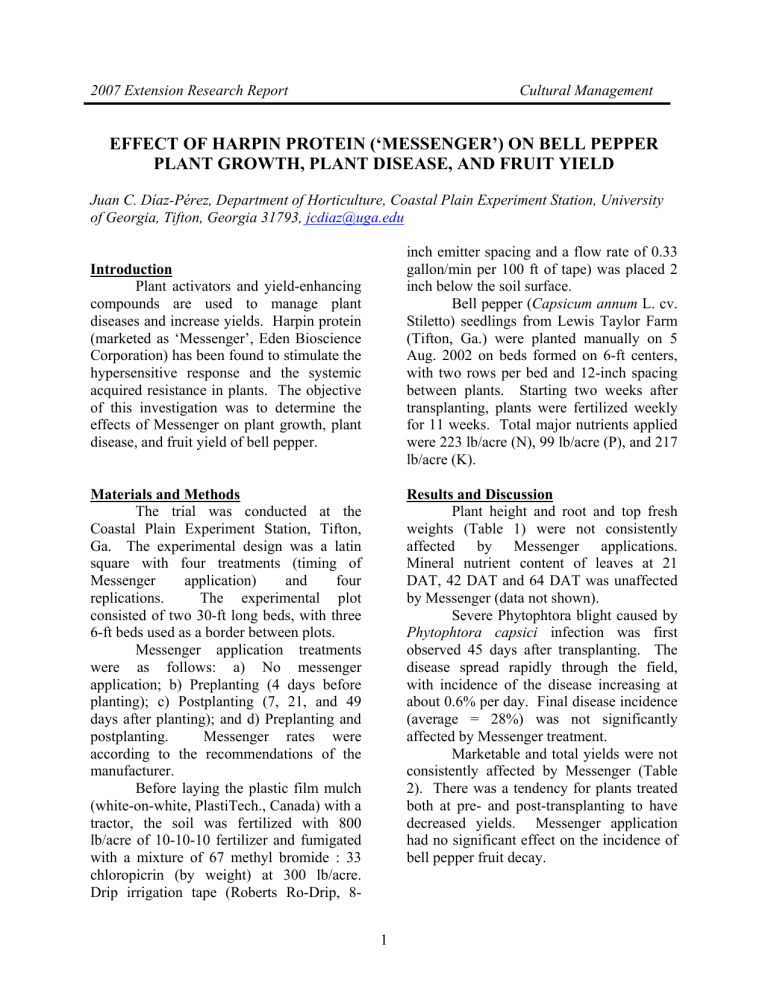
2007 Extension Research Report Cultural Management
EFFECT OF HARPIN PROTEIN (‘MESSENGER’) ON BELL PEPPER
PLANT GROWTH, PLANT DISEASE, AND FRUIT YIELD
Juan C. Díaz-Pérez, Department of Horticulture, Coastal Plain Experiment Station, University of Georgia, Tifton, Georgia 31793, jcdiaz@uga.edu
Introduction
Plant activators and yield-enhancing compounds are used to manage plant diseases and increase yields. Harpin protein
(marketed as ‘Messenger’, Eden Bioscience
Corporation) has been found to stimulate the hypersensitive response and the systemic acquired resistance in plants. The objective of this investigation was to determine the effects of Messenger on plant growth, plant disease, and fruit yield of bell pepper.
Materials and Methods
The trial was conducted at the
Coastal Plain Experiment Station, Tifton,
Ga. The experimental design was a latin square with four treatments (timing of
Messenger application) and four replications. The experimental plot consisted of two 30-ft long beds, with three
6-ft beds used as a border between plots.
Messenger application treatments were as follows: a) No messenger application; b) Preplanting (4 days before planting); c) Postplanting (7, 21, and 49 days after planting); and d) Preplanting and postplanting. Messenger rates were according to the recommendations of the manufacturer.
Before laying the plastic film mulch
(white-on-white, PlastiTech., Canada) with a tractor, the soil was fertilized with 800 lb/acre of 10-10-10 fertilizer and fumigated with a mixture of 67 methyl bromide : 33 chloropicrin (by weight) at 300 lb/acre.
Drip irrigation tape (Roberts Ro-Drip, 8inch emitter spacing and a flow rate of 0.33 gallon/min per 100 ft of tape) was placed 2 inch below the soil surface. lb/acre (K). pepper L. cv.
Stiletto) seedlings from Lewis Taylor Farm
(Tifton, Ga.) were planted manually on 5
Aug. 2002 on beds formed on 6-ft centers, with two rows per bed and 12-inch spacing between plants. Starting two weeks after transplanting, plants were fertilized weekly for 11 weeks. Total major nutrients applied were 223 lb/acre (N), 99 lb/acre (P), and 217
Results and Discussion
Plant height and root and top fresh weights (Table 1) were not consistently affected by Messenger applications.
Mineral nutrient content of leaves at 21
DAT, 42 DAT and 64 DAT was unaffected by Messenger (data not shown).
Severe Phytophtora blight caused by
Phytophtora capsici
infection was first observed 45 days after transplanting. The disease spread rapidly through the field, with incidence of the disease increasing at about 0.6% per day. Final disease incidence
(average = 28%) was not significantly affected by Messenger treatment.
Marketable and total yields were not consistently affected by Messenger (Table
2). There was a tendency for plants treated both at pre- and post-transplanting to have decreased yields. Messenger application had no significant effect on the incidence of bell pepper fruit decay.
1
In conclusion, the results of this study indicate that Messenger applications had no significant effects on plant growth, incidence of Phytophtora blight, fruit yield, and postharvest fruit decay in bell pepper.
However, these results are based only on a one-season trial. Thus, more research is necessary before more definite conclusions can be drawn on the effects of Messenger on bell pepper crop.
Table 1. Effect of Messenger applied pre- or post-transplanting on bell pepper growth at
42 days after transplanting.
Time of application Plant height (cm) Root fresh wt. (g) Top fresh wt. (g)
None applied
Pre-planting
Post-planting
Pre- and post-planting
18.1 a
17.9 ab
17.9 ab
16.8 b
14.7 a
12.0 b
14.5 a
15.0 a
120 ab
98 b
113 ab
124 a w Mean separation within columns by Duncan’s multiple range test at
P
≤ 0.05.
Table 2. Effect of Messenger applied at pre- or post-transplanting on bell pepper yields –
All Harvests combined.
Time of application
Marketable Total
Fruit number
(#/acre)
Fruit weight
(lb/acre)
Fruit number
(#/acre)
Fruit weight
(lb/acre)
None applied
Pre-planting
Post-planting
Pre- and post-planting
35,655 b
48,885 a
37,672 b
26,970 c
11,140 bc
14,773 a
11,920 ab
8,142 c
93,412 b
100,694 a
90,597 b
65,003 c w Mean separation within columns by Duncan’s multiple range test at P ≤ 0.05.
20,160 a
22,726 a
19,984 ab
13,730 b
2
